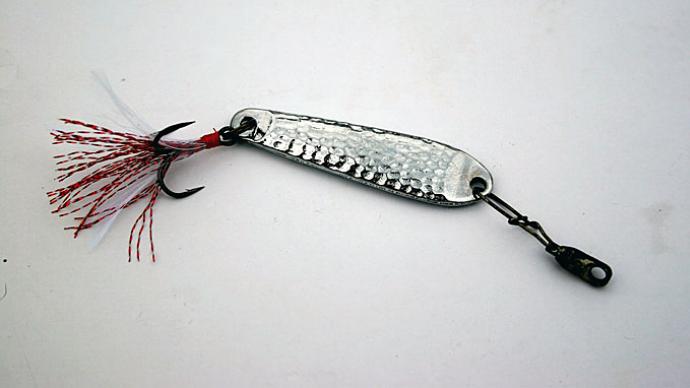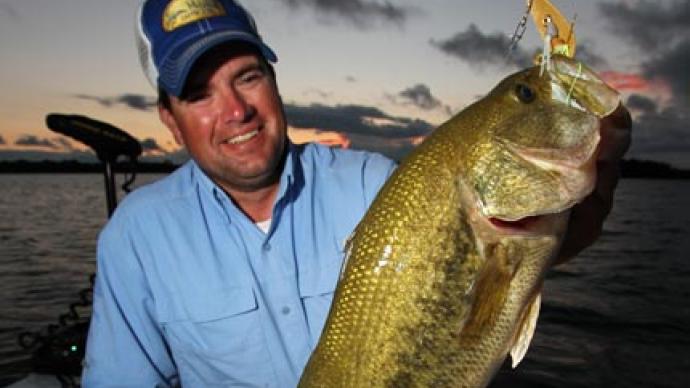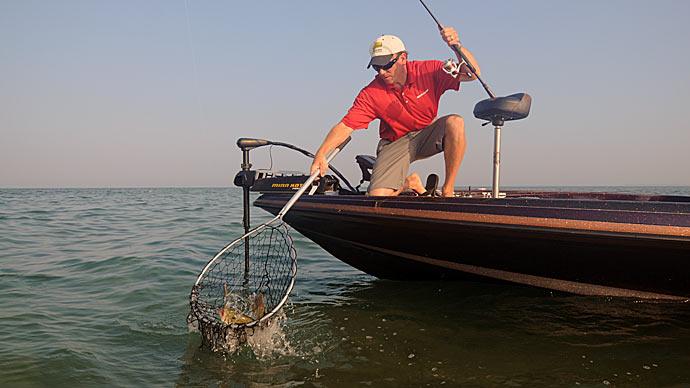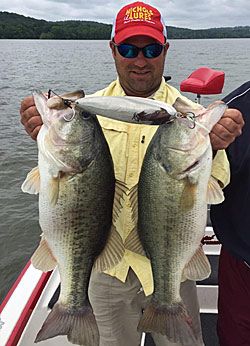
Kentucky Lake was flat on this clear summer afternoon. Ben Parker, a former Bassmaster Elite Series angler and current outfitter who guides waterfowl hunters and anglers in western Tennessee, was fishing solo. He was catching bass on a small flutter spoon, but they weren’t the giants that make the ledges on this 160,300-acre Tennessee Valley Authority reservoir so popular with anglers. Those bass had something else on their mind.
Now and then, Parker noticed big bass “jumping” baitfish much larger than the spoon he was casting. They were skipjack herring, which can grow to more than 1 foot long. At that moment, he had an epiphany. “If you’re going to match the hatch,” he asked himself, “then why aren’t you throwing a spoon the same size as the bait?”
Parker supplied designers at Nichols Lures with the length and width of the spoon he wanted, but it took several versions to refine its cup, which causes the action. When they finished, they had Parker’s namesake Magnum Flutter spoon, which measures 8 inches long and 2 inches wide and weighs 3.5 ounces. It looks more appropriate for saltwater fishing but has made a significant splash in bass fishing. “We’ve sold a ton of them,” Parker said. “We’ve sold thousands to Japan.”
Japanese anglers catch big bass with them at Lake Biwa, where Manabu Kurita caught the world-record tying 22-pound, 4-ounce bass in July 2009. In the U.S., Parker said the spoons are popular choices anywhere bass school deep, including Lake Eufaula and big Texas impoundments such as Toledo Bend. They have ruled tournaments on TVA lakes, and he used one equipped with a front stinger hook to catch two bass on one cast that together weighed 13 pounds. Nichols has since introduced larger and smaller versions. The Mini Magnum has caught smallmouth on Lake Champlain and the Great Lakes.
Parker’s design is the most significant change to spoon fishing in many years. Every bass angler can remember when their tackle box had spoons, maybe a Hopkins, Daredevil, or Moss Boss. As their skills advanced, other lures replaced those spoons. That was a mistake. Spoons are simple lures that catch bass. These lures can be used on the bottom, mid-depth, and surface.
Bottom
Jigging spoons are the only spoon that can be consistently found in the arsenals of today’s bass anglers. These spoons, such as the Hopkins Shorty, are compact, heavy, and fished with short hops off the bottom. They are usually fished vertically, but they also are productive when cast and hopped back to the boat, especially when targeting smallmouth bass.

Parker’s spoon adapts that latter presentation to largemouth fishing. “One thing that it has is a big profile,” he said. “It has a whole other thing with its shape and weight.” He said it would quickly move away from you if you cast the spoon out and let it sink on a free line. How far? He said as much as 20 or 30 feet on a deep ledge. He said a spoon cast to the middle during swimming pool tests would hit the back wall before the bottom. After he strokes the spoon off the bottom — quickly moving his rod from about the 3 o’clock to the noon position — he lets it sink on a slack line, allowing it to backtrack. That forces following bass to decide: eat it or get out of the way. Most eat it, he said.
Parker said fishing big flutter spoons demands a stiff rod from butt to tip. “You can’t throw it on any rod,” he said. He worked with ALX Rods to create one for giant fishing spoons. It was released at the 2016 ICAST show. The 7-foot, 7-inch rod casts spoons far and easily sets the hook at that distance. He uses 17-pound test fluorocarbon line and a reel with at least a 7:1 gear ratio. When a bass hits the spoon just after it starts falling, you’ll need to pick up the slack line before setting the hook. A speedy reel does that before the bass can let go of the spoon.
Parker’s spoons catch suspended bass, too. When he sees a school on his electronics, he’ll cast the spoon past it and let it sink to the bottom. He’ll start reeling, stopping once it passes through the school. It flutters back through, enticing strikes.
Bryan Thrift also likes to swim a spoon. The 2010 FLW Tour Angler of the Year, who has qualified for the Forest Wood Cup in each of the ten years he has fished the FLW Tour, has begun targeting bass schooling on the surface with a Damiki Backdrop spoon. Initially designed for saltwater fishing, it’s being released in freshwater sizes, which he said closely match the size of baitfish that most bass eat in fall 2016. “It’s unique because most other spoons are designed to be fished one way,” he said.
Backdrop spoons are flat on one side, but the other features a keel. On a slow retrieve, Thrift said, the spoon will stay near the surface and wobble, something schooling bass can’t resist. He also fishes the spoon vertically, like a traditional jigging spoon. After the spoon settles on the bottom, sharply snap your rod up a few feet. Follow the spoon as it sinks with a semi-tight line. That will allow the spoon to wobble and flash and you to feel a strike, mainly on the drop.
When fishing the Backdrop just under the surface, Thrift spools his reel with 12-pound test P-Line fluorocarbon line, which gives him extra casting distance. He steps up to 15-pound test when fishing it vertically. The Backdrop spoon features two free-swinging hooks rather than the usual single treble hook. You shouldn’t worry about hooking bass with them. In the short time he has experimented with the spoon; he has caught about 20 doubles. The hooks also make the spoon less likely to be thrown by a hooked bass.
Jigging spoons — whether the time-tested Hopkins, Parker’s super-sized flutter spoons, or Thrift’s best of both worlds Backdrop — work best when you know where bass are swimming. “Rarely do I go out and fish a spoon all day,” Thrift said. “It’s more of an opportunity bait.” Parker agrees with Thrift’s statement. If he doesn’t see a school of bass on the surface or his electronics, he won’t cast it. When he does, he’ll try it for 15 casts, and if there are no takers, he’ll put it down and try a different lure. He said the best opportunity to catch a bass on his spoon is the first two or three casts into the school.
Mid-depths
You had one presentation in mind when you tied your “beginner” spoons to your line. You were going to throw them out and wind them back. Swimming along in the mid-depths, spoons generate flash and a gentle, rhythmic vibration. That still catches bass.
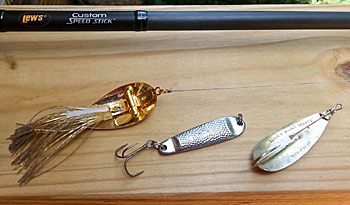
Smaller spoons with a deep cup, such as Acme’s Little Cleo, are best for swimming. Spoons with metallic finishes put off the most flash. Make sure the underside is raw metal if you choose a painted one. Sometimes the combination of flash and color can be the ticket. Use a small ball-bearing swivel or a split ring between your line and the spoon. It will twist your line otherwise.
A perfect situation for swimming a spoon is when bass school in the back of pockets and creeks in the fall. Like Thrift does with the Backdrop spoon, cast it toward the breaking bass and slow roll it through them. It’s easy to cast a spoon far, so stay back to avoid spooking the school.
Spoons give bass bombarded by spinnerbaits, jerkbaits, or square-bill crankbaits a different look. Their compact size, flash, and vibration will draw bass from submerged aquatic grass, laydowns, and even docks, but you will have to be more particular about your casting angles; its dangling rear treble hook snags easily. If you think that action is what the bass want but aren’t convinced a spoon will make it through the cover, try a weedless spoon such as a Johnson Silver Minnow. A weed guard protects its single hook.
Surface
Besides the Hopkins style of jigging spoon, the Johnson Silver Minnow is probably the best-known bass spoon. Its design has spawned similar weedless spoons, including Strike King’s Timber King, Northland’s Jaw-Breaker, and Heddon’s Moss Boss, that draw ferocious topwater strikes.
Weedless spoons are effective when aquatic grass is matted in sparse clumps or large fields. When matted grass is thick, heavy spoons leave an impression that’s deeper than hollow frogs or soft-plastic toads. That makes them easier for bass to find. That also helps entice unaggressive bass. With the spoon riding lower in the water, they don’t have to go as far to grab it.
A weedless spoon is perfect for swimming between emergent or matted grass patches. Let it sink, and then wind it under the surface before pulling it back over the next clump.
You’ll want to use a trailer on your weedless spoon. Some, such as the Jaw-Breaker, come fitted with a silicone skirt. Those are ready to go. But others, such as the Silver Minnow, come with a bare hook. Good trailer choices are straight-tail spinnerbait trailers or a plastic or pork chunk.
Not all surface spoons are made of metal. Lunker City, the company that started the soft jerkbait revolution in the 1980s with its Sluggo, makes one from soft plastic. The Salad Spoon, when viewed from above, has the same general shape as a spoon — narrow in the front and broader toward the back, where a sizeable grub-like tail protrudes from the lure. Texas rig it and throw it cover or open water. While it lacks most of the side-to-side shimmy of traditional weedless spoons, its grub-like tail makes a commotion slightly quieter than a toad.
BassResource may receive a portion of revenues if you make a purchase using a link above.


